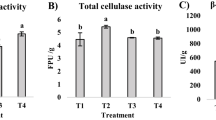Abstract
We report for the first time the development of a biodecaffeination process for tea synchronised with tea fermentation process using enzymes isolated from Pseudomonas alcaligenes. Cell-free extract was used for biodecaffeination of tea during fermentation of tea and 80% of the caffeine in the tea dhool was degraded within 90 min of incubation. Several factors that tend to effect the biodecaffeination during this stage, like moisture, aeration, intermittent enzyme addition and mixing, were optimized, and inhibitory interactions of proteins with polyphenols, caffeine–polyphenol interactions, which directly influence the biodecaffeination process were prevented by the use of glycine (5% w/w) in the dhool. Tea decaffeinated through the enzymatic route retained the original flavor and aroma, and there was an increase in the total polyphenol content of the tea.









Similar content being viewed by others
References
Camargo, M. C. R., & Toledo, M. C. F. (1998). Caffeine content of commercial Brazilian coffee. Ciencia Technologia de Alimentos, 18, 421–424.
Kretschmar, J. A., & Baumann, T. W. (1999). Caffeine in citrus flowers. Phytochemistry, 52, 19–23.
Caudle, A. G., & Bell, L. N. (2000). Caffeine and theobromine content of ready to eat chocolate cereals. Journal of the American Dietetic Association, 100, 690–692.
Woolfolk, C. A. (1975). Metabolism of N methylpurines by a Pseudomonas putida strain isolated by enrichment on caffeine as the sole source of carbon and nitrogen. Journal of Bacteriology, 123, 1088–1106.
Keya, C. A., Crozier, A., & Ashihara, H. (2003). Inhibition of caffeine biosynthesis in tea (Camellia sinensis) and coffee (Coffea arabica) plants by ribavirin. FEBS Letters, 554, 473–477.
Ogita, S., Uefuj, H., Yamaguchi, Y., Koizumi, N., & Sano, H. (2003). Producing decaffeinated coffee plants. Nature, 423, 823.
Sarath Babu, V. R., Patra, S., Thakur, M. S., Karanth, N. G., & Varadaraj, M. C. (2005). Degradation of caffeine by Pseudomonas alcaligenes CFR 1708. Enzyme and Microbial Technology, 37(6), 617–624.
Karl, J. S., Nataliia, V. T., & Penelope, Y. L. (1996). Nature of polyphenol–protein interactions. Journal of Agricultural and Food Chemistry, 44(1), 80–85.
Elisabeth, J., John, O'C. J., Patrick, A. F., Mike, P. W., (2004). Molecular model for astringency produced by polyphenol/protein interactions. Biomacromolecules, 5(3), 942–949.
Charlton, A. J., Davis, A. L., Jones, D. P., Lewis, J. R., Davies, A. P., Haslam, E., Williamson, M. P., (2000). The self-association of the black tea polyphenol theaflavin and its complexation with caffeine. Journal of the Chemical Society-perkin Transaction, 2, 317–322.
Shoshana, M. A., & Amos, E. R. (1976). Leaf cell water and enzyme activity. Plant Physiology, 57, 656–658.
Haslam, E. (1974). Polyphenol–protein interactions. Biochemical Journal, 139(1), 285–288.
Craft, N. E., Haitema, T., Brindle, L. K., Yamini, S., Humphrey, J. H., West, K. P. (2000). Retinol analysis in dried blood spots by HPLC. Journal of Nutrition, 130, 882–885.
Siebert, K. J., Carrasco, A., Lynn, P. Y. (1996). Formation of proteinpolyphenol haze in beverages. Journal of Agricultural and Food Chemistry, 44, 1997–2005.
Kotaro, K., Hiroe, Y., Chikara, H., & Hiroshi, S. (1998). Glycine protects against strong protein denaturing activity of oleuropin, a phenolic compound in privet leaves. Journal of Chemical Ecology, 24(4), 735–751.
Kellerhals, M., Hazenberg, W., & Witholt, B. (1999). High cell density fermentations of Pseudomonas oleovorans for the production of mcl-PHAs in two liquid-phase media. Enzyme and Microbial Technology, 24, 111–116.
Bradford, M. (1976). A rapid and sensitive method for the quantitation of microgram quantities of protein utilizing the principle of protein-dye binding. Analytical Biochemistry, 72, 248–254.
Asano, Y., Komeda, T., & Yamada, H. (1993). Microbial production of theobromine from caffeine. Bioscience, Biotechnology, and Biochemistry, 57, 1286–1289.
Lipman, F. (1943). Biological oxidations and reductions. Annual Review of Biochemistry, 12, 1–26.
Skujins, J. J., & McLaren, A. D. (1967). Enzyme reaction rates at limited water activities. Science, 158(3808), 1569–1570.
Yang, F., & Russell, A. J. (1996). The role of hydration in enzyme activity and stability: 1 Water adsorption by alcohol dehydrogenase in a continuous gas phase reactor. Biotechnology and Bioengineering, 49, 700–708.
Ravichandran, R., & Parthiban, R. (1998). The impact of processing techniques on tea volatiles. Food Chemistry, 62, 347–353.
Middelhoven, W. J., & Lommen, A. (1984). Degradation of caffeine by Pseudomonas putida C3024; the effect of oxygen concentration. Antonie Van Leeuwenhoek, 50, 298–300.
Thakur M. S., Vegesna R. S. B., Karanth N. G., & Varadraj C. (2006). Decaffeinating microorganism and process of biodecaffeination of caffeine containing solutions. US patent no. 7141411B2.
Collier, P. D., Mallows, R., & Thomas, P. E. (1972). Interactions between theaflavins, flavanols and caffeine. Phytochemistry, 11, 867.
Arnone, A., & Marchessault, R. H. (1968). Molecular association in biological and related systems. American Chemical Society Publication, 84, 235.
Wong, R. S. C., Hoffman, T., & Bennick, A. (1979). The complete primary structure of a proline-rich phosphoprotein from human saliva. Journal of Biological Chemistry, 254, 4800–4808.
Brown, A. G., Falsaw, C. P., Haslam, E., Holmers, A., & Ollis, W. D. (1966). The constitution of theaflavins. Tetrahedron Letters, 11, 1193–1204.
Chao, C. Y., & Chiang, H. B. (1999). Cream formation in a semifermented tea. Journal of the Science of Food and Agriculture, 79(13), 1767–1774.
Haslam, E. (2003). Thoughts on thearubigins. Phytochemistry, 64, 61–73.
Author information
Authors and Affiliations
Corresponding authors
Rights and permissions
About this article
Cite this article
Babu, V.R.S., Thakur, M.S. & Patra, S. Effect of Physicochemical Parameters on Enzymatic Biodecaffeination During Tea Fermentation. Appl Biochem Biotechnol 166, 112–126 (2012). https://doi.org/10.1007/s12010-011-9408-7
Received:
Accepted:
Published:
Issue Date:
DOI: https://doi.org/10.1007/s12010-011-9408-7




